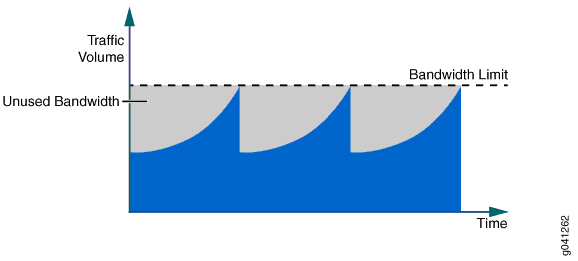Understanding the Benefits of Policers and Token Bucket Algorithms
This topic describes some scenarios that demonstrate how difficult it is to control traffic that comes into your network without the help of policers and the token bucket algorithm. These scenarios assume that traffic is coming from a TCP-based connection. Depending on the number of TCP connections, policers can have different affects on rate limits.
This topic presents the following scenarios:
Scenario 1: Single TCP Connection
Figure 1 shows the traffic loading on an interface with a policer configured. When the traffic rate reaches the configured bandwidth limit (which results in a packet drop), a TCP slow-start mechanism reduces the traffic rate down to half of what it was. When the traffic rate rises again, the same cycle repeats.

The problem presented in this scenario is that some bandwidth is available, but it is not being used by the traffic. The unused bandwidth shown in Figure 1 is the result of an overall data throughput that is lower than the configured bandwidth value. This example is an extreme case because there is only a single TCP connection.
Scenario 2: Multiple TCP Connections
With multiple TCP connections or some background non-TCP-based traffic, there is less unused bandwidth, as depicted in Figure 2. However, the same issue of unused bandwidth still exists if all the TCP connections experience a drop when the aggregated traffic rate exceeds the configured bandwidth limit.

To reduce the problem of unused bandwidth in your network, you can configure a burst size.
